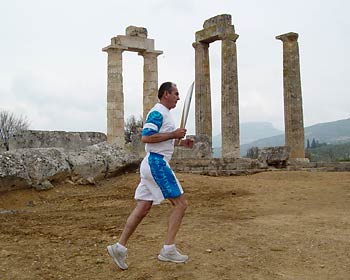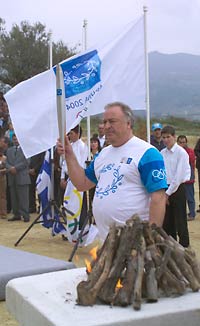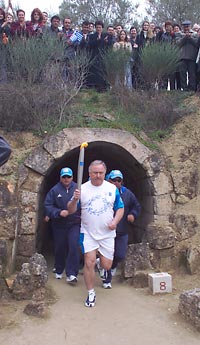UC Berkeley Web Feature
 |
Panayiotis Papadopoulos, a post office employee from Nemea, Greece, runs with the Olympic Torch past the Temple of Nemean Zeus at the UC Berkeley excavation site at Ancient Nemea. (Photos by Steve Miller / UC Berkeley) |
Ancient Greek athletic games to be revived at UC Berkeley archaeological site
BERKELEY – Just weeks before the 2004 Summer Olympic Games begin in Athens, ancient footraces that gave birth to the Olympics will be revived in a tiny Greek town 80 miles away - the result of more than 30 years of research by the University of California, Berkeley.
In Ancient Nemea, where the campus continues to excavate an athletic site used some 2,300 years ago for the original Panhellenic Games, more than 1,000 people from around the world are expected to converge on July 31 to sprint barefoot and in tunics down the same track used by ancient Greeks.
 Torchbearer Valery Borzov, a gold-medal sprinter at the 1972 Olympic Games, watches as the flame he has lighted on the Altar of the Nemean Games takes hold. |
At the end of the track, Borzov used the torch to light a flame on the altar that will burn through the end of July. The Olympic torch then continued on its five-continent relay, which culminates in Athens on Aug. 13.
The New Nemean Games, as they're known, were first held at the site in 1996 and have continued to take place every four years, just like the modern Olympic Games. But unlike the Olympics, the Nemean event is for untrained runners, awards no medals, can't be seen on TV and is not sponsored by famous corporations.
"The Olympic movement is a symbol of the nobler aspirations of our human race. But it also is increasingly removed from those who are not extraordinarily athletically gifted," said Stephen Miller, the UC Berkeley classical archaeology professor who has led digs in the village since 1973 and promotes the New Nemean Games.
The word "Panhellenic," he said, means "open to all Greeks." The Olympics are a direct descendant of the Panhellenic Games, which were held in Nemea, Olympia, Isthmia and Delphi.
Miller said that he and the villagers consider the 2004 New Nemean Games "a supplement, a complement, to the Olympics, because officials (planning the Olympics) have paid little attention to antiquities. They seem more concerned about showing Athens as a modern place."
Dr. Aristotelis Kallis, president of the Society for the Revival of the Nemean Games, added that the New Nemean Games are a "little sister" to the Olympics, but that, unlike this summer's games in Athens, they "will always be at Nemea, and that is due, ultimately, to the University of California."
The Nemean Games could not have been revived without the UC Berkeley research - excavations and subsequent analysis and study - conducted there for decades, said Miller, who joined the faculty in 1973 and plans to retire in December.
"Excavation for its own sake is ridiculous, like carrying out an experiment in a lab without application," he said. "Scholarly publications are important, but so are making results available to the general public."
 Borzov, carrying the Olympic torch, emerges from the entrance tunnel at the Ancient Nemea track to the cheers of local residents. |
In 1993, Miller led the reconstruction at the track of an ancient starting device made of wood, rope and cord that once launched the foot races in antiquity. A major project now in the works is the reconstruction of the temple, where athletes made sacrifices before competing. So far, two toppled columns of the original 34 are back in place - happily, said Miller, three others were not among those thrown down by vandals in 435 A.D.
The idea for the New Nemean Games came from a handful of residents who live near the archaeological site. After observing small-scale foot races held at the track in 1994 during a summer event celebrating the excavated stadium's completion, they approached Miller about how to keep bringing the stadium to life for the public. That December, the Society for the Revival of the Nemean Games was established, and it continues to organize the games.
For the 100-meter sprint, runners are organized by age and gender in groups of 12. They enter the ancient locker room, remove their clothes, don a simple tunic, and walk through the long entrance tunnel to await their turn on the track. After receiving a lane assignment drawn from a helmet, they take their places at the starting block and wait for a signal to begin the races. A 7.5 kilometer race also is run - from the ancient temple of Herakles near the town of Kleonai to the stadium.
The winner of each race immediately receives a ribbon around the head and a palm branch, and is awarded a crown of wild celery at the day's end.
"We want to give participants something of the feeling of an athlete in the fourth century B.C.," said Miller. "The direct contact of bare feet on ancient soil and starting blocks creates a sense of history that has to be experienced to be understood. Many people describe the chill bumps they felt as they passed through the entrance tunnel, from the 21st century A.D. to the fourth B.C."
The first races, in 1996, drew more than 650 mainly untrained runners from 29 countries, ranging in age from 10 to 93. The games featured judges, heralds and trumpeters dressed in ancient-looking garb. Runners included then-U.S. Ambassador to Greece Thomas Niles, then-UC Berkeley Chancellor Chang-Lin Tien and 1968 U.S. Olympic track coach Payton Jordan.
Thomas Miller, the current U.S. ambassador to Greece, attended Tuesday's ceremony. He said it was a "great joy to participate in this event and to see the culmination of 30 years of American work at Nemea . It is good luck for me and my wife that we will be here in Greece for the Olympics, but equally exciting to look forward to participating in the Nemean Games."
In 2000, 730 runners from 45 countries participated in the games. Among them were 16 ambassadors to Greece and UC Berkeley Chancellor Robert M. Berdahl, a historian who later wrote that the site is "a spectacular, visible presence of the University of California, Berkeley, in Greece."
This year, with the Olympics in Athens from Aug. 13-29, Miller predicts "a good-sized crowd" with some 1,200 runners competing.
Said Kallis, "Our games may be interesting to watch, but our real goal is participation, not observation. We want everyone and anyone who has the desire to experience something of the ancient games to register."
Those interested in participating should register by June 1 by sending their name, address, gender and age to the Society for the Revival of the Nemean Games, P.O. Box 2004, Nemea 205 00, Greece.

